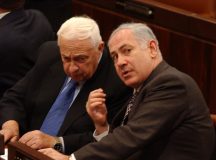How might the Israeli-Palestinian conflict have looked had Ariel Sharon not suffered two strokes that left him incapacitated? On the 15th anniversary of these events, Calev Ben-Dor draws on biographies and memoirs to consider whether Sharon would have implemented further unilateral withdrawals from the West Bank and what the potential consequences may have been.
The Palestinians, many Israelis lament, never miss an opportunity to miss an opportunity. That phrase, first coined by Abba Eban to refer to the ingrained habit of rejecting peace proposals by Arab states, has become an integral part of the Israeli narrative about the conflict. But like most things in the Middle East (and life in general), reality is more nuanced than the soundbite. Israel too has had its fair share of mistakes. And sometimes, perhaps more often than we realise, missed opportunities aren’t necessarily the fault of one side or another. Instead, they are the result of, to quote Bob Dylan, a simple twist of fate.
Take that wintery Jerusalem evening 15 years ago, 18 December 2005. During a brief conversation with his secretary, Prime Minister Ariel Sharon’s speech seemed a little strange. When informed of this, the family doctor ordered the Prime Minister be taken to hospital immediately. Yet Sharon seemingly recovered, and later that evening set out home to his Negev ranch. It was during the journey that he felt dizzy and was taken to Hadassah hospital in Jerusalem where doctors determined he had suffered a minor stroke and was hospitalised. Discharged after a mere day and a half, and receiving the blood thinning drug Clexane, Sharon was scheduled to undergo an angioplasty that was delayed by a fortnight.
On 4 January, while at his ranch – rather than in Jerusalem as hospital staff had recommended – the Prime Minister was struck by a second stroke, which included massive bleeding to the brain and which left him in a coma from which he never emerged. Half a year earlier, Sharon had implemented unilateral withdrawal from all Jewish settlements in Gaza and four more in the northern West Bank. He subsequently left the Likud party to create Kadima, which was expected to win more than 40 seats in the upcoming March 2006 elections.
A week after Sharon’s incapacitation, Hamas won the Palestinian parliamentary elections, and 18 months later violently seized the Gaza strip from Mahmoud Abbas’ Palestinian Authority. Sharon was replaced by Ehud Olmert, who won the March elections but with a much reduced 29 seats. While results were disappointing for Kadima, they were disastrous for Likud – which sank to an embarrassingly low 12 seats – as well as for its leader Benjamin Netanyahu. In The Netanyahu Years, journalist Ben Caspit describes how several senior MKs – including Silvan Shalom, Limor Livnat, Miki Eitan and Danny Naveh – sought to depose the Likud leader immediately after the election but were blocked by others in the party (who later regretted it). Meanwhile, under Olmert’s leadership, Kadima tried to split Likud by peeling away four rebel MKs. The move that would have left the party done and dusted with 8 seats and its leader without a realistic political future. Yet Olmert’s move failed. With the faction united, Netanyahu somehow emerged to fight another day as head of the opposition.
In the summer of 2006, after a Hezbollah ambush on the northern border killed several IDF soldiers, the Second Lebanon War broke out. With the benefit of hindsight, the war is perceived in significantly better light. In real time however, it was considered a disaster. Hezbollah rockets on the home front, coupled with Hamas’ takeover of Gaza following disengagement, completely undermined unilateralism as a policy.
The Second Lebanon War also altered the approach of the Bush administration. In Tested by Zion, the Bush Administration and the Israeli-Palestinian Conflict, Elliot Abrams relates that Bush had told Sharon in April 2005 that he was uninterested in moving towards a final-status agreement with the Palestinians if there was no progress in Gaza after disengagement (as indeed was the case). Yet the debacle of Lebanon led Secretary of State Condoleezza Rice to press for the idea of an international conference to solve the conflict. In her autobiography, No Higher Honor, a Memoir of my Years in Washington Rice recounts that when she became Secretary of State, she was focused on the achievement of Palestinian statehood. In the war’s aftermath and with Iraq and a nuclear Iran on her mind, she firmly told the Israelis that the US had a ‘strategic imperative to find an Israeli-Palestinian solution’.
The war also led to mass anti-government demonstrations, which weakened Olmert and revived Netanyahu’s political fortunes. The Prime Minister soldiered on, aiming (ultimately unsuccessfully) to reach a final-status deal with Abbas. But criticised by the Winograd Commission that was established to investigate the war, and beset by corruption scandals engulfing his premiership, Olmert’s popularity crashed, and his resignation ultimately led to new elections in February 2009. Kadima gained one more seat than Likud (29 to 28), but Netanyahu succeeded in forming a coalition. He has been Prime Minister ever since.
But what if…
Counterfactuals and their critics
Samuel Goldwyn once quipped that only a fool would make predictions – especially about the future. But what about an imagined, alternative past?
Counterfactual history, as this kind of imagining is called, is not everyone’s cup of tea, with some historians dismissing it as little more than a parlour game. British historian and diplomat E.H Carr dismissed what he calls ‘lapses into imaginary history’ and charged counterfactual theories with being arbitrary, speculative and self-serving. Richard J. Evans, Professor of Modern History at Cambridge argues that counterfactuals are merely a device to prop up historians’ ideological prejudices, and that ‘once you let the counterfactual genie out of the bag, anything can happen’.
The danger of being overly speculative (and self-serving) certainly exists. After all, Sharon was a heavily overweight 77-year-old, working long hours under extraordinary levels of stress, likely exacerbated by anxiety from the corruption cases surrounding him and his sons. Even had he not succumbed to his second stroke, who knows how long he would have remained Prime Minister. But let’s consider the following minimal historical rewrite, one I believe to be plausible.
A Plausible Historical Rewrite
Paying closer heed to his doctors’ orders, Sharon doesn’t suffer the second, fatal stroke. The non-comatose Prime Minister continues to lead Kadima and wins 40-45 seats in the March elections, as polls predicted. The Likud party is decimated, stuttering to single digits. Netanyahu is forced out and retires from political life.
The Prime Minister’s survival doesn’t do anything to counter Hamas’ parliamentary victory. Nor can his government prevent the Islamist group’s takeover of Gaza 18 months later. But due to Sharon’s historical trauma from the First Lebanon War – after which he had been unceremoniously dumped as Defence Minister after being found indirectly responsible for the Phalangist atrocities in Sabra and Shatila – he responds with restraint to Hezbollah’s ambush.
In this scenario, there is no month-long war, no perceived failure, and no anti-government protests. Unilateralism remains a popular policy with a strong Knesset majority in support of further significant withdrawal(s) from the West Bank.
What might Sharon have done?
In answering how Sharon might have utilised this position, it’s worth referring to a conversation reported in Be Strong and of Good Courage: How Israel’s Most Important Leaders Shaped Its Destiny, by Dennis Ross and David Makovsky. In the introduction, they relate how Sharon said his generation was ‘the last one that is not afraid to make big decisions,’ adding that he feared ‘the next generation will be led by politicians and they won’t decide’.
But would such a ‘big decision’ have involved territorial withdrawal? In his masterful biography Arik, The Life of Ariel Sharon David Landau emphasises the Prime Minister’s unequivocal assertion that disengagement was a one-off event, never to be repeated. But the author adds that these statements were ‘then subjected to equivocal parsing by his aides and closer advisers’ who ‘created a deliberate cloud of obfuscation around his intentions, pumping out contradictory statements on the record and off’. According to Landau, ‘Sharon’s wink and nod policy, which for so long had characterised the expansion of Israel’s settlement map was now, it seemed, to be applied to its contraction’.
Months before his stroke, Sharon instructed his Chief of Staff Dubi Weisglass to discreetly establish a committee of top civil servants with explicit instructions to study options for further West Bank unilateral withdrawals. Steven Hadley, National Security Advisor in the Bush administration’s second term, recently recalled Sharon showing him a map that included his plans for a withdrawal from 85 per cent of the West Bank. Hypotheticals inherently don’t lend themselves to certainty, but as Landau notes, ‘friend and foe alike assumed he [Sharon] intended a further substantial contraction of the settlement deployment during his next term’.
With unilateralism retaining its lustre among the public and with a large Knesset majority, it’s difficult to see how Sharon could have been stopped. Violence from national-religious ‘Greater Land of Israel’ advocates would almost certainly have taken place, perhaps on a greater scale than during the Gaza disengagement. But ultimately, those living outside the so-called main settlement blocs would have moved or been removed. Had the IDF remained in the area (as it did when those four West Bank settlements were evacuated during disengagement) a Hamas takeover would have been prevented. The situation on the ground would remain stable.
The Bush administration would almost certainly have welcomed these policies. Secretary of State Rice – who, without the war in Lebanon is spared her own diplomatic trauma – feels no need to promote final-status talks between the sides. Instead, Bush frames Sharon’s policy as the fulfilment of the second phase of the Roadmap, which called for the creation of a ‘Palestinian State in Provisional Borders’. Partial, de-facto partition transforms the conflict from one of occupier and occupied to that of a border dispute between two states.
A panacea this is certainly not. Hamas still controls Gaza. An armed-to-the-teeth Hezbollah continues to threaten in the north. And the gaps between Israel and the Palestinian Authority on refugees, Jerusalem and territory remain. Shimon Peres’ ‘New Middle East’ will have to wait.
What then? The farther we travel from the original event, the harder (and more fantastical) mapping out potential consequences becomes. Perhaps Salam Fayyad’s programme of state building (initiated as Palestinian Prime Minister between 2007-2013) constitutes a constructive complimentary move to Sharon’s withdrawals? Alternatively, maybe Israeli unilateralism deals a mortal blow to the Palestinian Authority and Abbas’ strategy of bilateral negotiations? The end of the Greater Land of Israel dream may have sent disastrous shock waves through parts of Israeli society. And what of Netanyahu? Would he have remained in the political wilderness or sought to return to fix his image and ‘save’ the country?
Ultimately, one can never ignore the influence of what former British Prime Minister Harold Macmillan told a journalist he most feared – ‘events, dear boy, events’.
Whether the above hypothetical scenario is considered a dream or nightmare is indicative of one’s present-day politics. Fifteen years on, prime ministers, presidents, and peace plans have come and gone. Yet with partition as distant as ever, and arguments over missed opportunities a staple part of political discourse, it remains instructive to revisit how things may have turned out had the last member of the so-called generation ‘unafraid of making big decisions’ not left the stage 15 years ago.




































